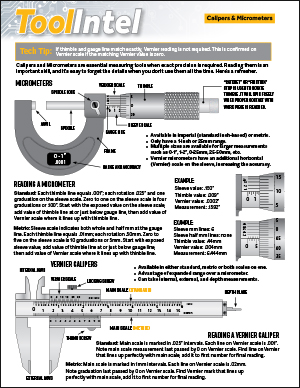Economical cars are going to be in bigger demand as fuel prices continue to soar. But having a car that can handle the family and provide the utility needed to take off into the backcountry is still going to appeal to a lot of people. Subaru has the vehicles that can provide that sort of all-around coverage. Every model has the ability to serve as commuter and grocery getter, and still be able to get to just about anywhere one would want to go in any kind of weather. With all-wheel-drive being standard on all of the current models, I very often recommend them as the best compromise for a do-everything vehicle. Of course, they’re also durable and reasonably priced.
Maintenance costs are becoming an issue with many drivers these days, as the manufacturers’ “normal” service intervals are being stretched to lessen the impact on their pocketbooks. The problem is that these maintenance schedules tend to make the services performed less preventive, and more like postponed, until failure is evident. As independent providers of automotive service, it’s our job to win and then keep customers for life, and that means treating them as a partner in our success. When we take over the care of a customer’s car from the dealer, we need to change the meaning of what is recommended and outline what’s best for long, problem-free service.
Just about any manufacturer can build a vehicle that will survive the initial warranty period with probably no service at all. There are still some people who try to make that happen, and then pass the car onto someone else to deal with the lack of care and the resulting damage.
The point of this article is to go over what can and should be done on a “complete” service, what to look for, what to recommend and why we need to take the additional time and care to do it right so the customer has the confidence to keep bringing the car back when other things need to be addressed. Although this article is directed at Subaru models, these same practices are applicable to any other vehicle make or model.
GETTING STARTED
When I worked as a Service Advisor at a dealership several years ago, my approach was to listen to what customers wanted from their vehicles, mostly reliability and longevity, and then tailor the recommended services to fit their particular use of the vehicle. I had a very loyal and friendly clientele, and was often given “difficult” customers because I took the time to work with them. Learning something about each customer, and determining how they’re going to use their vehicle, should influence how you service their needs.
In Western Washington where I live and work, that means taking into account the fact that about half of the people who live here probably spend the winter months skiing at mountain resorts that are thousands of feet above sea level, or spend their free time at sea level doing things on the water, like fishing or boating. The other half spends a lot of their time just commuting at under 10 mph. Determining the driving conditions makes all the difference in the world when it comes to the inspection and servicing of their vehicles. Subarus are particularly suited to the various uses indicated above. A look in the parking lot at one of the ski lodges is like looking at a dealership lot — with lots of Subarus topped with roof racks filled with skis, snowboards and storage lockers. Cars with rusty under-carriages, abused brakes, dented undercarriages and even sandblasted suspensions are just as common, as a lot of people spend time at the beach or try to find that secret fishing hole or campsite.
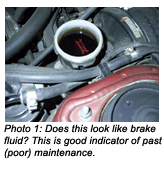 PROVIDING VALUE
PROVIDING VALUE
The most important part of selling automotive service to customers is giving value to the work you do. Trying to sell a maintenance service based on just an arbitrary mileage or time-based schedule will only work with people who find value in that it will actually prevent future repairs.
In the following sections, I’ll go over my standard routine for doing an annual service. I may or may not be any more thorough than the next guy, but I take pride in doing what’s necessary and expected (See Photo 1). By being thorough, you can make honest assessments on the remaining time before a repair will be needed, and that gives your customer a chance to prepare for the inevitable.
INSPECTION AND ROAD TEST
Assuming we’re doing a complete annual service and checkup, there are certain steps I like to take to ensure that the vehicle will make it through the next year, needing only normal maintenance (oil changes) and expected repairs. A short road test before the inspection is a good idea, just to give you some things to focus on. If a tuneup is part of the service, this is a good time to do a check for codes and get a baseline for data from the ECU. The car must be put on a hoist or over a pit and everything should be looked at and the condition documented when a concern is found. I’ve always advocated an inspection form or checklist as part of the normal service procedure, as it takes the guesswork out of what was found, especially when the vehicle comes back for repairs. Whether you design your own form, use a commercially produced one or a blank piece of notebook paper really doesn’t matter, as long as maintenance needs that are found make their way onto it. Also, having a pry bar or large set of pliers handy to move suspect components like ball joints, bushings and tie rod ends allows you to make better judgments.
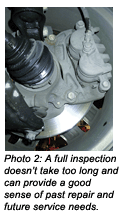 UNDERCAR
UNDERCAR
A complete inspection of the bottom of the car can be done while the oil is draining from the crankcase. Having a “system” when doing the inspection makes it easy and complete. I use a bright flashlight for inspection, as it allows you to focus light on any particular spot that might be a problem. I usually start at the front bumper and work back, just by habit. A quick inspection is usually guided by looking for leaks; obvious impact damage or what was felt or heard on the road test. I try to cover everything visually, like the brake linings for obvious uneven wear (See Photo 2), the shocks, springs, exhaust and suspension components. I especially look for locations where rust stains are an indication that there is metal-to-metal contact. In some areas of the country, that might not be as good an indication of a problem, but here in the northwest, rust is not that common, especially where the rain does a good job of keeping everything clean. The rear brakes on most Subaru models since the early 1990s have a parking brake mechanism of the internal expanding type with shoes and an adjuster. This system does not have a self-adjusting mechanism built into it. I make an assessment of the park brake before I put the car on the hoist and if the lever travel is excessive, I adjust it during this inspection. It’s just one of those small, insignificant adjustments that most drivers will notice immediately when they pick up the car, and realize that you really did work on the car. This is a simple starwheel adjustment through the backing plate that takes about a minute to perform.
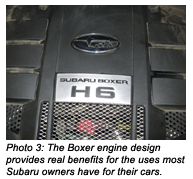 GOING UNDER THE HOOD
GOING UNDER THE HOOD
With the inspection complete, the oil drained and filter replaced, it’s time to move to the underhood area. A note is in order here. Most late-model Subarus with automatic transaxles have a spin-on filter on the transmission. We’ve seen a number of these crushed by, we assume, inexperienced technicians mistaking that filter for the engine filter. If it’s damaged (it gets damaged when removed since it’s installed very tightly), it must be replaced with the proper automatic transmission filter. There is considerably more pressure inside the transmission than a normal engine filter would typically handle.
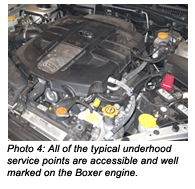 The design of all Subaru models over the last 15 years or so has been with the horizontally opposed 4- or 6-cylinder “boxer” engines (See Photo 3). The design has a number of advantages, but for the technician, there are also some tradeoffs. The good thing for most models is that the underhood area is open and all of the typical service points are on top and within easy reach (See Photo 4). Even though most of the normal service points are in full view, removing the engine trim covers (See Photo 5) is a good idea to allow inspection of hoses, wiring or any indication that there may have been rodent nests started. For some reason, this has become a common problem. Some theories are related to the possibility that soy-based insulation has become a delicacy and is easier to digest than other plastics.
The design of all Subaru models over the last 15 years or so has been with the horizontally opposed 4- or 6-cylinder “boxer” engines (See Photo 3). The design has a number of advantages, but for the technician, there are also some tradeoffs. The good thing for most models is that the underhood area is open and all of the typical service points are on top and within easy reach (See Photo 4). Even though most of the normal service points are in full view, removing the engine trim covers (See Photo 5) is a good idea to allow inspection of hoses, wiring or any indication that there may have been rodent nests started. For some reason, this has become a common problem. Some theories are related to the possibility that soy-based insulation has become a delicacy and is easier to digest than other plastics.
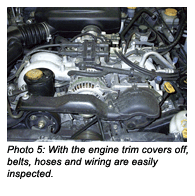 On the DOHC engines though, the spark plugs are in a very difficult and restricted position in the center of the cam covers. They’re usually easier to remove from under the car by removing the little splash panels under the radiator on each side. Using the correct match of socket, extension and a universal will make this job easier, but by no means simple.
On the DOHC engines though, the spark plugs are in a very difficult and restricted position in the center of the cam covers. They’re usually easier to remove from under the car by removing the little splash panels under the radiator on each side. Using the correct match of socket, extension and a universal will make this job easier, but by no means simple.
The first problem, especially on neglected engines, is getting the spark plug wires to release from the spark plugs. There is no universal method that seems to work; a boot puller, needle nose pliers or strong fingers have worked for me, but there can be problems like the terminal end coming loose from the secondary wire (See Photo 6), or just breaking off inside the boot. It’s a good idea to look into replacing the wires as a set where removal requires anything more than easy removal.
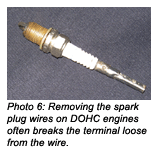 Since these engines do not have distributors with the problems of resistance in the cap and rotor, the plug wires are a lot more critical to the operation of the ignition system. For future removal (consider that you’ll be servicing this car for life), a coat of silicone paste on the rubber that goes over the porcelain part of the plug will make subsequent removal much easier.
Since these engines do not have distributors with the problems of resistance in the cap and rotor, the plug wires are a lot more critical to the operation of the ignition system. For future removal (consider that you’ll be servicing this car for life), a coat of silicone paste on the rubber that goes over the porcelain part of the plug will make subsequent removal much easier.
One other area of concern under the hood is the ducting for the air intake. Some models used a MAF sensor at the air filter housing, with a long hose connected to the throttle body. If the hose is cracked or was left loose, there were obvious driveability issues. On later models, the air filter is attached directly to the throttle body. The main thing to remember with any of these cars is that intake air leakage at any point will cause serious engine smoothness issues. Even a small vacuum hose leak on one side of the engine will cause an engine “rock” that can be felt throughout the car.
Another problem with the cars that have the air filter housing on the inner right fender is noise on acceleration. It can be a little tricky to get the cover back on correctly unless you loosen the clamps at both ends of the hose to the throttle body. This will allow you to get the lower edge of the filter cover properly installed over the tabs on the lower part of the bottom housing. Remember to retighten the hose clamps to prevent the intake leaks as noted above.
Cooling system service is pretty conventional, except there is a problem with getting the system completely full unless you use a vacuum-fill system and there are no leaks. Without the vacuum-fill system, the procedure takes patience to slowly fill the system and bleed off air with the bleeder screw in the upper hose neck. Another trick here is to loosen one of the heater hoses at the back of the engine to bleed off air that might be trapped in the heater core if the system is fully drained. In either case, the car should be idled for awhile before driving to be sure the system did fill completely, allow the car to cool and then recheck before returning the car to the customer after a test drive. I like to make sure the overflow bottle is about half full before a road test, just so there will be sufficient fluid to fill the system if an air pocket somehow makes it through all of the fill procedures.
FINISHING UP
The number of Subarus sold in the U.S. in nearly 40 years will ensure repair work for the foreseeable future. As solid, dependable and useful cars, they can’t be beat. The company has stayed with the same basic design long enough that once you learn the differences between models; service becomes profitable and predictable for the shop and technician.
As I stated at the start of this article, with gas prices climbing, these cars will be the ones that people will hold onto, service and expect to hold up with normal maintenance. Keeping your customers will be easier if you learn to work with them in determining the proper way to service and maintain their vehicles, without forgetting to take into consideration how they use them.









